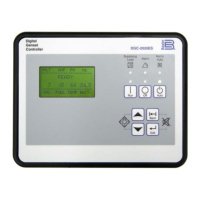5-6 9469200995
Device Configuration DGC-2020ES
Crank Disconnect
Under normal operation, engine rpm is used to determine crank disconnect. The Crank Disconnect Limit
setting establishes the engine rpm percentage at which the starter is disconnected. This setting accepts
values from 10 to 100, in increments of 1 percent.
The Oil Pressure Crank Disconnect provides a secondary indication that the engine is running. This
ensures that the starter is disconnected, even if no engine rpm sources are functioning. When enabled,
oil pressure is used to determine if the engine is running. If the engine oil pressure is above the threshold,
the starter is disconnected from the engine. The Crank Disconnect Pressure threshold setting accepts
values from 2.9 to 150 psi, 0.2 to 10.3 bar, and 20 to 1,034.5 kPa, in increments of 0.1.
Cool Down
After the load is removed from a genset, the DGC-2020ES implements a smart cooldown function. This
function ensures that the engine and turbocharger properly cool down by maintaining engine operation for
a user-defined duration.
This cooldown function is initiated for any one of the following conditions:
• Genset load is removed and engine shutdown is permitted while in AUTO mode
• Auto Transfer switch (ATS) opens while operating in AUTO mode
• Remote shutdown is initiated while in AUTO mode
• Off Mode Cooldown is initiated
• The Cooldown Request logic element is initiated
• The Cool and Stop Request logic element is initiated
Settings
Off Mode Cool Down: Upon receiving a cool down request with this setting enabled, the unit will enter a
cool down cycle when in Off mode.
Cool Down Configuration: Upon receiving a cool down request with Only When Loaded selected, the
unit will enter a cool down cycle only if a load is currently applied. With Always selected, the unit will enter
a cool down cycle upon request with or without a load applied.
No Load Cool Down Time: This setting establishes the duration of the cool down cycle when no load is
applied.
Smart Cooldown Function
The smart cooldown function reduces unnecessary fuel expenditure by considering overall cooldown time
through multiple requests. For example, a new cooldown request is initiated after a previous cooldown
sequence has already started. The cooldown timer is not simply reset with each new request. Instead, the
amount of time that the engine has spent cooling down is factored into the new request. This saves time
and fuel by running the engine no longer than necessary to achieve proper cooldown.

